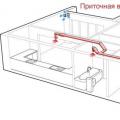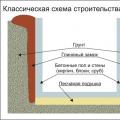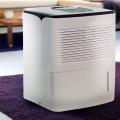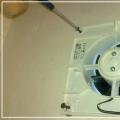By default, air exchange in the apartment is provided by natural exhaust ventilation. Think of the holes with grates in the ceiling in the bathroom and in the kitchen. From them there are ventilation ducts from the apartment to the common house exhaust shaft, which opens onto the roof. Through these channels, stuffy air is removed from the apartment to the outside. But it is necessary not only to remove the air, but also to supply fresh air from the street.
Air can enter the house through open windows. But as soon as they are closed, the outside air ceases to flow into the apartment. And without an inflow, there is no exhaust. On the other hand, dirty air with exhaust gases, allergens and bacteria enters the apartment through open windows. If you are allergic, then in the summer poplar fluff, pollen of plants and flowers are added here. And in winter, when the immune system is already weakened by the fight against viruses and microbes, open windows give you "dangerous" drafts, which does not bode well for your health.
Why do you need fresh air ventilation?
without supply ventilation
With traditional ventilation through the windows into the apartment gets in dirt, noise, bacteria and odors.
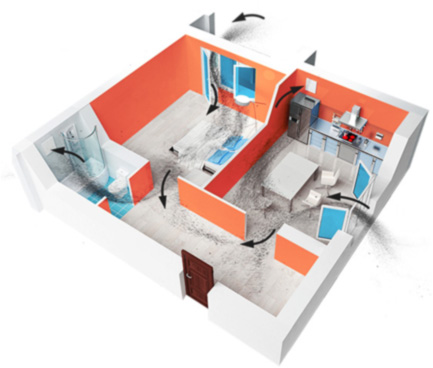
With forced ventilation
Inflow Provides ventilation and cleans incoming air simultaneously.
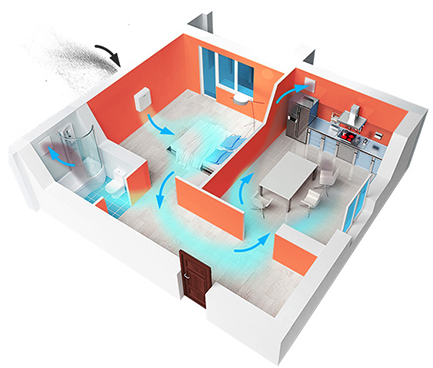
The answer is simple:
Supply ventilation is needed for the apartment
She may be central or compact. Central - this is when there is a ventilation unit under the false ceiling or on the balcony, which drives air through pipes that are stretched through all rooms.Such ventilation "eats up" a lot of space, requires serious repairs and is expensive.Central ventilation makes sense if you have a private house or apartment undergoing major renovations.
If the apartment already has a fine finish, then it will be a pity to break the interior for laying air ducts. It is easier and cheaper to install compact supply ventilation:ventilator or breather... These are small appliances that are wall-mounted and supply fresh air through a through duct.
We assumed that most of the readers' apartment has already been renovated, therefore, in this article, we paid attention to compact ventilation. Let's figure out what you should pay attention to before buying a ventilator.
1. Performance
According to the norms, the minimum productivity is 30 cubic meters of air per hour for one person. To ensure that there is enough fresh air for all family members, it is desirable that there is a fan in the supply ventilation. The more powerful it is, the more fresh air it will bring.
2. Air filtration
City air is an explosive mixture of exhaust gases, dust, industrial emissions, and also allergens in the spring. A good cleaning system with several filters can hold this whole cocktail. For large particles - a filter of class G (coarse cleaning) or class F (fine cleaning), for small particles - more efficient filters of class H (so-called HEPA filters), for harmful gases - carbon filters.
3. Price
The cost of installing ventilation in a panel house (and in a brick one too) depends on the parameters of the ventilator. In any case, compact devices are much cheaper than central supply and exhaust ventilation for an apartment with air filtration. It costs about 100 thousand rubles and even more. You can buy supply ventilation for an apartment with filtration for a price of no more than 22 thousand, and a supply valve - 2-3 thousand.
4. Additional parameters
There are compact supply ventilation systems with heated air in the apartment, with a different number of fan speeds and, accordingly, with different noise levels, and so on.
Below is a comparative table in which you can evaluate different types of supply ventilation for all the listed parameters.
Types of apartment ventilation systems
| Supply ventilation type | Performance | Filtration | Extra options | Price with installation |
| Supply valve |
from 0 to 54 m3 / h |
No | No | 5 900 rub |
| Ventilator | from 10 to 160 m3 / h for one room |
either a charcoal filter, or coarse filter G3 |
no air heating, |
22 490 rbl |
| Breezer | from 30 to 130 m3 / h for one room |
three filters: |
heating from -40 ° С to + 25 ° С |
28 900 rub |
| Central supply ventilation | about 300-500 m3 / h for the whole apartment |
additional filters |
water or electric air heating, low noise level, at extra charge you can install modules cooling and humidifying the air |
about 100,000 rubles + expenses for additional modules + repair costs |
Installation of the ventilation system in the wall of the apartment
With the exception of central ventilation, other types of supply units practically do not differ in the complexity of installation. Both for supply valves, and for ventilators, and for breathers, it is required to drill a through channel in the wall to draw air from the street.

For drilling, a special diamond drilling machine and an industrial vacuum cleaner are used. The installation process takes 1-2 hours and does not spoil the finished repair. Unlike the installation of central ventilation (we talked about this at the beginning of the article).
Conclusion: compact ventilation is the best choice
In all respects, compact supply ventilation is not inferior to central ventilation. As for the cost, it is cheaper to install 2-3 ventilators or breathers for a typical apartment than to spend the same money on central ventilation. And the same amount for repairs after laying the air ducts.
1. Choose a supply valve if you live in an environmentally friendly and warm region, you want to protect yourself from street noise and you only need minimal ventilation (at the level of a slightly open window).
2. Choose a ventilator if you live in the same warm and environmentally friendly region, but you want more intensive ventilation than a slightly open window.
3. Choose a breather if you live in a noisy and dusty city and you need a lot of air - not only fresh, but also clean.

